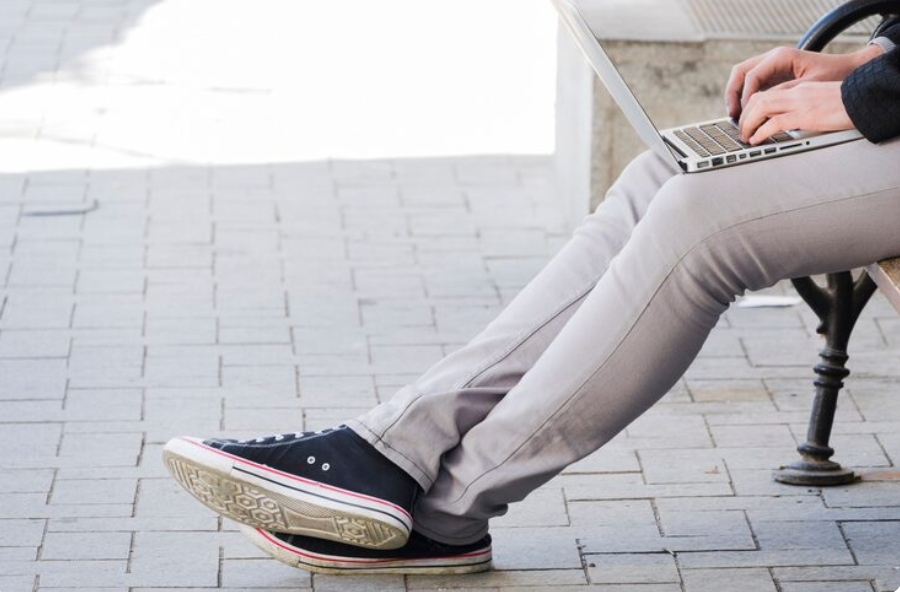Blog
Air Conditioned Shoes: The Future of Cool Comfortable Footwear

Footwear has always played a vital role in human life, evolving from simple protective coverings to stylish, functional, and technologically advanced gear. In today’s era of innovation, one of the most fascinating and futuristic developments is air conditioned shoes. Designed to provide cooling comfort, these shoes combine modern engineering with everyday utility, making them ideal for athletes, outdoor workers, and fashion-conscious consumers alike. This article explores the history, design, benefits, challenges, and future of air conditioned shoes in detail, highlighting why they are more than just a fashion trend but a revolutionary step in footwear technology.
Origins of Footwear Technology
Footwear has historically adapted to meet the changing needs of humans. Early shoes were made from natural materials like leather, wood, or woven fibers, meant only for protection. Over time, shoes evolved into fashion items and performance tools. From sports sneakers to orthopedic footwear, technology continuously enhanced comfort and utility.
The introduction of air conditioned shoes represents a new frontier in this progression. It builds upon earlier innovations like breathable mesh fabrics, moisture-wicking socks, and cushioned insoles, taking comfort one step further by directly controlling temperature.
The Concept of Air Conditioned Shoes
Air conditioned shoes are specifically engineered footwear designed to regulate temperature within the shoe, keeping feet cool in hot environments and comfortable in humid conditions. They incorporate small fans, ventilation systems, or cooling gels to prevent overheating, sweat buildup, and discomfort.
This concept is not purely about luxury—it addresses a real problem faced by millions. Heat and moisture inside shoes often cause blisters, odor, fungal infections, and overall discomfort. By tackling these issues, air conditioned shoes offer a practical solution that improves both hygiene and performance.
How Air Conditioned Shoes Work
The design of air conditioned shoes varies depending on the manufacturer, but most models use one of three main technologies:
- Built-in Micro Fans: Tiny battery-powered fans circulate air throughout the shoe, creating ventilation and reducing moisture.
- Cooling Gels and Pads: Special materials that absorb heat and keep the interior temperature lower than the external environment.
- Ventilation Channels: Strategically placed air vents that allow heat to escape while maintaining structural support.
In some advanced models, rechargeable batteries and USB ports are used to power cooling systems. The mechanics are seamlessly integrated into the shoe’s design, ensuring that performance and style are not compromised.
The Rise of Wearable Technology
The introduction of air conditioned shoes aligns with the global trend of wearable technology. Just as smartwatches, fitness trackers, and AR glasses have blended utility with personal style, these shoes represent a step toward merging footwear with high-tech innovation.
Wearable technology is increasingly focused on enhancing human comfort and productivity. By keeping feet cool and dry, air conditioned shoes fit perfectly into this growing category, showing how even traditional clothing items are being transformed by science and engineering.
Benefits of Air Conditioned Shoes
The popularity of air conditioned shoes is not just due to novelty. They offer several real-world benefits that make them practical and desirable:
- Enhanced Comfort: Cooling prevents discomfort during long hours of wear, especially in hot climates.
- Improved Hygiene: Reduced moisture lowers the risk of odor and fungal infections.
- Performance Boost: Athletes benefit from dry, comfortable feet that improve endurance and agility.
- Workplace Utility: Outdoor workers, soldiers, and first responders find relief in extreme heat conditions.
- Fashion Appeal: Futuristic designs appeal to style-conscious consumers.
By addressing both health and lifestyle concerns, these shoes bridge the gap between necessity and luxury.
Air Conditioned Shoes for Athletes
Athletes are among the biggest beneficiaries of this innovation. Sports like running, basketball, and soccer demand intense footwork, which generates heat and sweat inside the shoe. Overheating can cause fatigue, blisters, and slower recovery times.
Air conditioned shoes help regulate temperature, allowing athletes to maintain peak performance for longer durations. Some models even combine cooling with cushioning technology, ensuring maximum comfort during training and competition. This could potentially revolutionize athletic footwear in the same way air-cushion soles once did.
Workplace Applications
For people working in extreme environments—construction workers, military personnel, delivery drivers—foot comfort can directly impact productivity and safety. Sweaty or overheated feet can lead to slips, skin irritation, or even infections.
Air conditioned shoes provide consistent cooling, reducing fatigue and maintaining focus. In industries where protective footwear is mandatory, integrating air conditioning systems adds a layer of health protection without compromising safety standards.
Fashion and Lifestyle Impact
In addition to practical applications, air conditioned shoes have become a fashion statement. Brands are experimenting with sleek, futuristic designs that integrate cooling technology without appearing bulky. From streetwear to luxury collections, these shoes are gradually making their way into mainstream style.
Consumers are increasingly drawn to products that blend function with fashion. Just as sneakers became a cultural symbol of individuality, air conditioned shoes could emerge as the next big footwear trend, especially among younger, tech-savvy buyers.
Challenges in Design and Adoption
Despite their benefits, air conditioned shoes face certain challenges that limit widespread adoption.
- Battery Life: Cooling systems powered by fans or electronics require reliable energy sources. Short battery life can frustrate users.
- Weight and Bulkiness: Integrating cooling technology without making shoes heavy or uncomfortable is a challenge.
- Durability: Daily wear-and-tear may affect the functionality of built-in systems.
- Cost: Advanced materials and technology make these shoes more expensive than standard footwear.
Overcoming these challenges will be key to making air conditioned shoes more accessible to the masses.
Innovations in Materials
Modern air conditioned shoes rely heavily on advanced materials. Lightweight polymers, breathable fabrics, and energy-efficient cooling components are used to create shoes that feel natural and stylish.
Some experimental designs use phase-change materials (PCMs) that absorb and release heat depending on temperature changes, maintaining consistent comfort without electricity. Others explore graphene-enhanced fabrics for heat dissipation and durability.
These innovations highlight the intersection of material science and fashion, pushing the boundaries of footwear design.
Environmental Considerations
With growing awareness of sustainability, manufacturers must also consider the environmental impact of air conditioned shoes. Using rechargeable batteries, recyclable materials, and eco-friendly fabrics can make these shoes more sustainable.
Furthermore, reducing excessive energy use in electronic cooling systems is important. Designing passive cooling mechanisms—like ventilation and natural airflow—ensures that environmental concerns do not outweigh the benefits.
Consumer Reception
Early adopters of air conditioned shoes have shown strong enthusiasm, praising the comfort and uniqueness of the design. However, mainstream consumers remain cautious, often concerned about price and durability.
Marketing strategies that highlight health benefits, performance improvements, and style appeal are helping to build wider interest. As more brands experiment with affordable models, consumer acceptance is expected to grow.
The Role of Major Footwear Brands
Several well-known shoe manufacturers have already experimented with cooling systems. Some introduced prototypes with fan-based designs, while others focused on breathable mesh technologies that mimic air conditioning effects.
The role of major brands will be crucial in popularizing the concept. Their ability to combine large-scale production with innovative marketing can transform air conditioned shoes from a niche product into a mainstream staple.
Integration with Smart Features
Future models of air conditioned shoes may integrate with smartphones or wearable devices. Imagine a pair of shoes that adjusts cooling automatically based on foot temperature or outdoor weather conditions.
Some concepts even explore biometric monitoring, where shoes track steps, calories, and temperature simultaneously. This fusion of cooling technology with smart features could redefine what people expect from footwear in the digital age.
Market Trends and Future Growth
The footwear industry is massive, with billions spent annually on sports shoes, fashion sneakers, and comfort footwear. Air conditioned shoes occupy a unique niche that bridges all three categories.
As wearable technology continues to grow, market analysts predict increased demand for such hybrid products. With proper innovation, prices will drop, making them affordable to wider audiences. This could lead to rapid expansion in both developed and emerging markets.
Cultural Influence and Popularity
Pop culture has also contributed to the fascination with futuristic footwear. From science fiction movies to celebrity endorsements, high-tech shoes have captured the imagination of audiences worldwide. Air conditioned shoes fit perfectly into this narrative, representing the blend of innovation and style that modern consumers crave.
As influencers and athletes showcase these shoes on social media, their popularity will only increase. The combination of practicality and visual appeal makes them a perfect fit for digital-era trends.
Comparing with Traditional Footwear

Compared to traditional shoes, air conditioned shoes stand out for their unique temperature-control feature. While conventional shoes rely on breathable fabrics and moisture-wicking insoles, they cannot actively regulate heat.
Air conditioned shoes, on the other hand, go beyond passive comfort to offer active cooling. This distinction could position them as premium footwear, appealing to people who prioritize health, comfort, and cutting-edge design.
Future Possibilities
The possibilities for air conditioned shoes are vast. Future designs may include solar-powered cooling, self-cleaning fabrics, or even adaptive soles that adjust cushioning based on activity.
With rapid advancements in nanotechnology and AI, shoes could one day become intelligent companions that not only keep feet cool but also enhance athletic performance, prevent injuries, and provide personalized comfort settings.
Final Thought
Air conditioned shoes represent a fascinating convergence of fashion, technology, and functionality. By addressing the age-old problem of overheated, sweaty feet, they provide comfort, hygiene, and performance benefits unmatched by traditional footwear.
While challenges like cost, durability, and sustainability remain, the potential of these shoes is undeniable. As innovation continues and consumer demand grows, air conditioned shoes could become a mainstream reality, transforming the way we think about footwear.
From athletes to workers to fashion enthusiasts, everyone stands to benefit from this revolutionary step in shoe design. Ultimately, air conditioned shoes prove that the future of footwear is not only about style but also about intelligent comfort and advanced technology.
-

 Tech1 year ago
Tech1 year agoHow to Use a Temporary Number for WhatsApp
-

 Business2 years ago
Business2 years agoSepatuindonesia.com | Best Online Store in Indonesia
-

 Social Media1 year ago
Social Media1 year agoThe Best Methods to Download TikTok Videos Using SnapTik
-

 Technology1 year ago
Technology1 year agoTop High Paying Affiliate Programs
-

 Tech10 months ago
Tech10 months agoUnderstanding thejavasea.me Leaks Aio-TLP: A Comprehensive Guide
-

 FOOD1 year ago
FOOD1 year agoHow to Identify Pure Desi Ghee? Ultimate Guidelines for Purchasing Authentic Ghee Online
-

 Instagram3 years ago
Instagram3 years agoFree Instagram Auto Follower Without Login
-

 Instagram3 years ago
Instagram3 years agoFree Instagram Follower Without Login




















